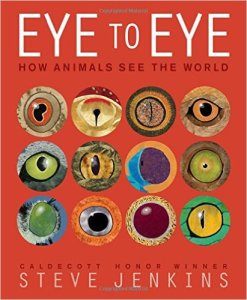 Nonfiction Picture Book Challenge 2015 is a weekly celebration of imaginative children’s nonfiction materials hosted by Kid Lit Frenzy.
Nonfiction Picture Book Challenge 2015 is a weekly celebration of imaginative children’s nonfiction materials hosted by Kid Lit Frenzy.
I missed Nonfiction Picture Book Wednesday last week, and I missed it terribly, so I made sure to block aside some time for my favourite post of the week!
Title: Eye to Eye: How Animals See The World
Author/Illustrator: Steve Jenkins
Publisher: HMH Books for Young Reader
Publication Date: 2012
Genre/Format: Nonfiction/Picture Book
Publisher’s Summary: In his latest eye-popping work of picture book nonfiction, the Caldecott Honor–winning author-illustrator Steve Jenkins explains how for most animals, eyes are the most important source of information about the world in a biological sense. The simplest eyes—clusters of light-sensitive cells—appeared more than one billion years ago, and provided a big survival advantage to the first creatures that had them. Since then, animals have evolved an amazing variety of eyes, along with often surprising ways to use them.
My Two Cents: I don’t think it’ll surprise anyone when I say that I really enjoyed this book! I love Steve Jenkins – his nonfiction picture books are consistently impressive. This one, all about the anatomy of animal eyes, is indeed eye-popping (ha ha..), thanks to Jenkins’ signature blend of paper cut illustrations and engaging facts. The natural world is just so breathtaking, and I think nonfiction picture books like this work so well because they seem to share and indeed validate children’s natural curiosity and sense of wonder. There’s also a bit of a gross factor via the illustrations of the inner workings of animal eyes, which is always a kid pleaser. 🙂
Side note: There’s a brilliant adult nonfiction book that touches on evolution, including the evolution of the eye across different species: You Inner Fish by Neil Shubin.

Title: When I Was Eight
Author: Christy Jordan-Fenton, Margaret Pokiak-Fenton
Illustrator: Gabrielle Grimard
Publisher: Annick Press
Publication Date: 2013
Genre/Format: Nonfiction/Picture Book
Publisher’s Summary: Nothing will stop a strong-minded young Inuit girl from learning how to read. Olemaun is eight and knows a lot of things. But she does not know how to read. She must travel to the outsiders’ school to learn, ignoring her father’s warning of what will happen there.The nuns at the school take her Inuit name and call her Margaret. They cut off her long hair and force her to do chores. She has only one thing left — a book about a girl named Alice, who falls down a rabbit hole. Margaret’s tenacious character draws the attention of a black-cloaked nun who tries to break her spirit at every turn. But she is more determined than ever to read. By the end, Margaret knows that, like Alice, she has traveled to a faraway land and stood against a tyrant, proving herself to be brave and clever. Based on the true story of Margaret Pokiak-Fenton, and complemented by stunning illustrations, When I Was Eight makes the bestselling Fatty Legs accessible to young children. Now they, too, can meet this remarkable girl who reminds us what power we hold when we can read.
My Two Cents: This adaptation of Jordan-Fenton’s novel Fatty Legs is a semi-autobiographical account of the author’s experiences as a child in a residential school. Although made gentler for young audiences, Olemaun’s story is a deeply painful one – a story of separation, neglect, cultural destruction, and abuse, but it is also a story of strength, determination, and hope. In a particularly heartbreaking twist on the residential school story, Olemaun actually begs her father to allow her to go to the school, believing that the “outsiders” will teach her to read. Instead she faces an almost unending series of attacks, both physical and psychological, not only from the nuns running the school but from the other students, as well. It takes all of Olemaun’s inner strength not to lose her sense of self or her dream or reading. When I Was Eight is an important story, beautifully presented, that should be shared with children in a supportive environment- children will likely have questions about Olemaun and her experiences, and this information needs to be shared in a sensitive and respectful way. This would be perfect as part of Canadian history studies or a unit on residential schools or Aboriginal history. Beautiful, and highly recommended.

Love Steve Jenkins! He’s one of the best!
I didn’t know When I Was Eight–thank you for sharing!
It’s definitely a beautiful book, and a worthy addition to a collection on Canadian or Aboriginal history. Thanks for stopping by!
We love both of these books. Steve Jenkins categorizes information in such interesting ways
Red Bird Sings by Gina Capaldi and Q.L. Pearce is another nonfiction picture book that tells the story of a native child caught in an unsympathetic educational system (my review http://www.annettebaypimentel.com/red-bird-sings/), but it’s dense and really for a much older reader. I’m so happy to learn about When I Was Eight. Thanks for the recommendation!
I hope you enjoy it! Nicola Campbell’s “Shi-shi-etko” is another beautiful picture book dealing with residential schools, though it’s fiction.